Identification and Evaluation of the Main Constraints on Cotton Production Within a Collective Drip Irrigation System in Southern Xinjiang, China
Abstract
1. Introduction
2. Materials and Methods
2.1. Site Description
2.2. Crop Management
2.3. Data Collection
2.3.1. Irrigation Management and N Fertilizer Application
2.3.2. Soil Sampling and Laboratory Analyses
2.3.3. Plant Sampling and Measurements
2.4. Data Analysis
2.4.1. Statistical Analysis
2.4.2. Boundary Line Analysis
2.4.3. Structural Equation Model
3. Results
3.1. Identifying the Main Constraints in the CDIS
3.1.1. Constraints and Seed Cotton Yields
3.1.2. The Responses of Cotton Production to the Constraints
3.2. Influence of the Main Constraints on Cotton Growth
3.2.1. Soil Texture and Irrigation Management
3.2.2. Soil Moisture
3.2.3. Soil Inorganic Nitrogen
3.2.4. Cotton N Uptake
3.2.5. Yield, IWP and PFPN
3.2.6. Comprehensive Analysis of the Factors Affecting Cotton Growth
4. Discussion
4.1. Constraints to Cotton Production in the CDIS
4.2. Influence of Constraint Factors on Cotton Growth in DISs
4.3. Suggestions for Cotton Production Under Drip Irrigation Management
4.4. Strengths and Limitations of the Study
5. Conclusions
- Among the six constraint factors evaluated in the CDIS, excessive irrigation and poor soil texture were identified as the primary constraints, affecting more than 45% of the drip-irrigated cotton fields.
- Excessive irrigation and poor soil texture significantly influence soil moisture and Nmin in cotton fields, directly limiting the water/nitrogen use efficiency (IWP and PFPN) under drip irrigation management. This phenomenon leads to substantial variations in cotton growth within the CDIS.
- The differences in Nmin caused by the main constraints (excessive irrigation and poor soil texture) were the primary factors affecting cotton nitrogen uptake and subsequent yield reductions. Ensuring the N supply was the key to addressing the yield decline in the drip irrigation system.
- Three suggestions according to the current management situation were derived to address cotton decline within the CDIS: (i) optimized irrigation scheduling; (ii) an improved drip irrigation network; and (iii) adjusted drip fertilization strategies. Future research could further focus on the response of cotton quality to multiple constraints within the CDIS. This will help optimize the management of drip irrigation and improve the quality of local cotton production.
Author Contributions
Funding
Data Availability Statement
Conflicts of Interest
References
- FAOSTAT. Food and Agriculture Organization Corporate Statistical Database. Available online: http://www.fao.org/faostat/ (accessed on 5 June 2024).
- National Bureau of Statistics of China. 2022. Available online: https://www.stats.gov.cn/sj/ndsj/2023/indexch.htm (accessed on 5 June 2024).
- Bai, Z.T.; Xie, C.; Yu, J.; Bai, W.Q.; Pei, S.Z.; Li, Y.X.; Li, Z.J.; Zhang, F.C.; Fan, J.L.; Yin, F.H. Effects of irrigation and nitrogen levels on yield and water-nitrogen-radiation use efficiency of drip-fertigated cotton in south Xinjiang of China. Field Crops Res. 2024, 308, 109280. [Google Scholar] [CrossRef]
- Daccache, A.; Lamaddalena, N.; Fratino, U. Assessing pressure changes in an on-demand water distribution system on drip irrigation performance—Case study in Italy. J. Irrig. Drain. Eng. 2010, 136, 261–270. [Google Scholar] [CrossRef]
- Darouich, H.M.; Pedras, C.M.G.; Gonçalves, J.M.; Pereira, L.S. Drip vs. surface irrigation: A comparison focussing on water saving and economic returns using multicriteria analysis applied to cotton. Biosyst. Eng. 2014, 122, 74–90. [Google Scholar] [CrossRef]
- Zhang, H.; Xu, A. Present situation, problems and countermeasures of cotton industry in Xinjiang of China. China Cotton Process 2020, 5, 18–20, (In Chinese with English abstract). [Google Scholar]
- Hou, X.H.; Fan, J.L.; Zhang, F.C.; Hu, W.H.; Xiang, Y.Z. Optimization of water and nitrogen management to improve seed cotton yield, water productivity and economic benefit of mulched drip-irrigated cotton in southern Xinjiang, China. Field Crops Research 2024, 308, 109301. [Google Scholar]
- Guan, C.K.; Ma, X.L.; Shi, X.P. The impact of collective and individual drip irrigation systems on fertilizer use intensity and land productivity: Evidence from rural Xinjiang, China. Water Resour. Econ. 2022, 38, 100196. [Google Scholar] [CrossRef]
- Gatti, M.; Garavani, A.; Squeri, C.; Diti, I.; Monte, A.d.; Scotti, C.; Ponie, S. Effects of intra-vineyard variability and soil heterogeneity on vine performance, dry matter and nutrient partitioning. Precis. Agric. 2022, 23, 150–177. [Google Scholar] [CrossRef]
- Ma, R.; Dou, S.; Zhang, Y.F.; Wu, D.; Ndzelu, B.S.; Xie, S.; YaLiHong, D. Different soil particle size changes the 15N re-tention in soil and 15N utilization by maize. Sci. Total Environ. 2022, 843, 157133. [Google Scholar] [CrossRef]
- Jiang, H.; Tian, Y.Q.; Yan, W.J.; Chen, J.J.; Zhang, Z.X.; Xu, H.H. Drip chemigation of flonicamid effectively controls cot-ton aphid (Aphis gossypii) and is benign to lady beetle (Coccinella septempunctata) and lacewing larva (Chrysoperla sinica). Crop Prot. 2022, 129, 105039. [Google Scholar] [CrossRef]
- Webb, R.A. Use of the Boundary Line in the analysis of biological data. J. Hortic. Sci. 1972, 47, 309–319. [Google Scholar] [CrossRef]
- Lark, R.M. An empirical method for describing the joint eff ects of environmental and other variables on crop yield. Ann. Appl. Biol. 1997, 131, 141–159. [Google Scholar] [CrossRef]
- Walworth, J.L.; Letzsch, W.S.; Sumner, M.E. Use of boundary lines in establishing diagnostic norms. Soil Sci. Soc. Am. J. 1986, 50, 123–128. [Google Scholar] [CrossRef]
- Wairegi, L.W.I.; Asten, P.J.A.V.; Tenywa, M.M.; Bekunda, M.A. Abiotic constraints override biotic constraints in East African highland banana systems. Field Crops Res. 2010, 117, 146–153. [Google Scholar] [CrossRef]
- Wang, N.; Jassogne, L.; van Asten, P.J.A.; Mukasa, D.; Wanyama, I.; Kagezi, G.; Giller, K.E. Evaluating coffee yield gaps and important biotic, abiotic, and management factors limiting coffee production in Uganda. Eur. J. Agron. 2015, 63, 1–11. [Google Scholar] [CrossRef]
- Lin, S.D.; Wang, Q.J.; Deng, M.J.; Su, L.J.; Wei, K.; Guo, Y.; Zhang, J.H. Assessing the influence of water fertilizer, and climate factors on seed cotton yield under mulched drip irrigation in Xinjiang Agricultural Regions. Eur. J. Agron. 2024, 152, 127034. [Google Scholar] [CrossRef]
- Zhou, Y.Q.; Li, F.; Xin, Q.C.; Li, Y.M.; Lin, Z.D. Historical variability of cotton yield and response to climate and agro-nomic management in Xinjiang, China. Sci. Total Environ. 2024, 912, 169327. [Google Scholar] [CrossRef] [PubMed]
- Vories, E.; O’Shaughnessy, S.; Sudduth, K.; Evett, S.; Andrade, M.; Drummond, S. Comparison of precision and conventional irrigation management of cotton and impact of soil texture. Precis. Agric. 2021, 22, 414–431. [Google Scholar] [CrossRef]
- Wang, Z.; Li, J.; Zhang, H.; Li, Y. Analyzing the influence of drip irrigation uniformity on spring maize yield using the spatial effect model. Sci. Agric. Sin. 2013, 46, 4905–4915, (In Chinese with English abstract). [Google Scholar]
- Lin, X.M.; Wang, Z.; Li, J.S. Identifying the factors dominating the spatial distribution of water and salt in soil and cotton yield under arid environments of drip irrigation with different lateral lengths. Agric. Water Manag. 2021, 250, 106834. [Google Scholar] [CrossRef]
- China Meteorological Administration. Available online: https://data.cma.cn (accessed on 5 June 2024).
- Fernández, J.E.; Alcon, F.; Diaz-Espejo, A.; Hernandez-Santana, V.; Cuevas, M.V. Water use indicators and economic analysis for on-farm irrigation decision: A case study of a super high density olive tree orchard. Agric. Water Manag. 2020, 237, 106074. [Google Scholar] [CrossRef]
- Chen, B.P.; Guo, L.J.; Tang, J.C.; Li, Y.S.; Li, C.F. Comprehensive impacts of different integrated rice-animal coculture systems on rice yield, nitrogen fertilizer partial factor productivity and nitrogen losses: A global meta-analysis. Sci. Total Environ. 2024, 915, 169994. [Google Scholar] [CrossRef]
- Schnug, E.; Heym, J.; Achwan, F. Establishing critical values for soil and plant analysis by means of the boundary line development system (bolides). Commun. Soil Sci. Plant Anal. 1996, 27, 2739–2748. [Google Scholar] [CrossRef]
- Fermont, A.M.; van Asten, P.J.A.; Tittonell, P.; van Wijk, M.T.; Giller, K.E. Closing the cassava yield gap: An analysis from smallholder farms in East Africa. Field Crops Res. 2009, 112, 24–36. [Google Scholar] [CrossRef]
- Shatar, T.M.; Mcbratney, A.B. Boundary-line analysis of field-scale yield response to soil properties. J. Agric. Sci. 2004, 142, 553–560. [Google Scholar] [CrossRef]
- Grace, J.B. Structural Equation Modeling and Natural Systems; Cambridge University Press: Cambridge, UK, 2006. [Google Scholar]
- Lu, J.S.; Hu, T.T.; Geng, C.M.; Cui, X.L.; Fan, J.L.; Zhang, F.C. Response of yield, yield components and water-nitrogen use efficiency of winter wheat to different drip fertigation regimes in Northwest China. Agric. Water Manag. 2021, 255, 107034. [Google Scholar] [CrossRef]
- Liao, Z.Q.; Zhang, C.; Yu, S.L.; Lai, Z.L.; Wang, H.D.; Zhang, F.C.; Li, Z.J.; Wu, P.; Fan, J.L. Ridge-furrow planting with black film mulching increases rainfed summer maize production by improving resources utilization on the Loess Plateau of China. Agric. Water Manag. 2023, 289, 108558. [Google Scholar] [CrossRef]
- Shao, M.A.; Wang, Q.J.; Huang, M.B. Soil Physics; Higher Education Press: Beijing, China, 2006. [Google Scholar]
- Wang, Z.; Zhang, Z.H.; Li, J.S.; Li, Y.F. Field evaluation of fertigation performance for a drip irrigation system with different lateral layouts under low operation pressures. Irrig. Sci. 2022, 40, 191–201. [Google Scholar] [CrossRef]
- Scarpin, G.J.; Bhattarai, A.; Hand, L.C.; Snider, J.L.; Roberts, P.M.; Bastos, L.M. Cotton lint yield and quality variability in Georgia, USA: Understanding genotypic and environmental interactions. Field Crops Res. 2025, 325, 109822. [Google Scholar] [CrossRef]
- Feike, T.; Khor, L.Y.; Mamitimin, Y.; Ha, N.; Li, L.; Abdusalih, N.; Xiao, H.; Doluschitz, R. Determinants of cotton farmers’ irrigation water management in arid Northwestern China. Agric. Water Manag. 2017, 187, 1–10. [Google Scholar] [CrossRef]
- Tan, S.; Wang, Q.J.; Zhang, J.H.; Chen, Y.; Shan, Y.Y.; Xu, D. Performance of AquaCrop model for cotton growth simulation under film-mulched drip irrigation in southern Xinjiang, China. Agric. Water Manag. 2018, 196, 99–113. [Google Scholar] [CrossRef]
- Baird, J.; Schwenke, G.; Macdonald, B.; Nachimuthu, G.; McPherson, A.; Mercer, C. Efficiency over excess: Maximising cotton lint yields with optimum irrigation and nitrogen fertiliser application. Field Crops Res. 2024, 315, 109484. [Google Scholar] [CrossRef]
- Souza, S.A.; Rodrigues, L.N.; da Cunha, F.F. Assessing the precision irrigation potential for increasing crop yield and water savings through simulation. Precis. Agric. 2023, 24, 533–559. [Google Scholar] [CrossRef]
- Jisha, K.C.; Vijayakumari, K.; Puthur, J.T. Seed priming for abiotic stress tolerance: An overview. Acta Physiol. Plant 2023, 35, 1381–1396. [Google Scholar] [CrossRef]
- Mauget, S.A.; Himanshu, S.K.; Goebel, T.S.; Ale, S.; Lascano, R.J.; Gitz, D.C. Soil and soil organic carbon effects on simulated Southern High Plains dryland Cotton production. Soil Tillage Res. 2021, 212, 105040. [Google Scholar] [CrossRef]
- Li, Y.; Chen, Z.; Chen, Y.; Li, T.; Wang, C.; Li, C. Predicting the spatial distribution of soil organic carbon in the clack soil area of northeast plain, China. Sustainability 2025, 17, 396. [Google Scholar] [CrossRef]
- Klein, V.A.; Baseggio, M.; Madalosso, T.; Marcolin, C.D. Textura do solo e a estimativa do teor de água no ponto de murcha permanente com psicrômetro (soil texture and water content estimation at permanent wilting point with psychrometer). Ciência Rural 2010, 40, 1550–1556. [Google Scholar] [CrossRef]
- Barzegari, M.; Sepaskhah, A.R.; Ahmadi, S.H. Irrigation and nitrogen managements affect nitrogen leaching and root yield of sugar beet. Nutr. Cycl. Agroecosyst. 2017, 108, 211–230. [Google Scholar] [CrossRef]
- Tsibart, A.S.; Dillen, J.; Elsen, A.; Postelmans, A.; van De Ven, G.; Saeys, W. Potential to reduce the nitrate residue after harvest in maize fields without sacrificing yield through precision nitrogen management. Precis. Agric. 2024, 25, 940–962. [Google Scholar] [CrossRef]
- Sun, X.L.; Yang, X.S.; Hu, Z.Y.; Liu, F.L.; Xie, Z.J.; Li, S.Y.; Wang, G.X.; Li, M.; Sun, Z.; Bol, R. Biochar effects on soil nitrogen retention, leaching and yield of perennial citron daylily under three irrigation regimes. Agric. Water Manag. 2024, 296, 108788. [Google Scholar] [CrossRef]
- Pool, S.; Francés, F.; Garcia-Prats, A.; Puertes, C.; Pulido-Velazquez, M.; Sanchis-Ibor, C.; Schirmer, M.; Yang, H.; Jiménez-Martínez, J. Impact of a transformation from flood to drip irrigation on groundwater recharge and nitrogen leaching under variable climatic conditions. Sci. Total Environ. 2022, 825, 153805. [Google Scholar] [CrossRef]
- Manderscheid, R.; Pacholski, A.; Frühauf, C.; Weigel., H.J. Effects of free air carbon dioxide enrichment and nitrogen supply on growth and yield of winter barley cultivated in a crop rotation. Field Crops Res. 2009, 110, 185–196. [Google Scholar] [CrossRef]
- Zurweller, B.A.; Rowland, D.L.; Mulvaney, M.J.; Tillman, B.L.; Migliaccio, K.; Wright, D.; Erickson, J.; Payton, P.; Vellidis, G. Optimizing cotton irrigation and nitrogen management using a soil water balance model and in-season nitrogen applications. Agric. Water Manag. 2019, 216, 306–314. [Google Scholar] [CrossRef]
- Shareef, M.; Gui, D.W.; Zeng, F.J.; Waqas, M.; Ahmed, Z.; Zhang, B.; Iqbal, H.; Xue, J. Nitrogen leaching, recovery efficiency, and cotton productivity assessments on desert-sandy soil under various application methods. Agric. Water Manag. 2019, 223, 105716. [Google Scholar] [CrossRef]
- Bange, M.P.; Milroy, S.P.; Thongbai, P. Growth and yield of cotton in response to waterlogging. Field Crops Res. 2004, 88, 142. [Google Scholar] [CrossRef]
- Sedghi, N.; Cavigelli, M.; Weil, R. Soil texture, fertilization, cover crop species and management affect nitrous oxide emissions from no-till cropland. Sci. Total Environ. 2024, 914, 169991. [Google Scholar] [CrossRef] [PubMed]
- Kurunc, A.; Ersahin, S.; Yetgin Uz, B.; Sonmez, N.K.; Uz, I.; Kaman, H.; Bacalan, G.E.; Emekli, Y. Identification of nitrate leaching hot spots in a large area with contrasting soil texture and management. Agric. Water Manag. 2011, 98, 1013–1019. [Google Scholar] [CrossRef]
- Usowicz, B.; Lipiec, J. Spatial variability of soil properties and cereal yield in a cultivated field on sandy soil. Soil Tillage Res. 2017, 174, 241–250. [Google Scholar] [CrossRef]
- Xiao, C.; Zhang, F.C.; Li, Y.; Fan, J.L.; Xu, X.T.; Liu, X.Q. Optimal drip irrigation leaching amount and times enhance seed cotton yield and its stability by improving soil chemical environment and source-sink relationship. Field Crops Res. 2024, 317, 109531. [Google Scholar]
- Benouniche, M.; Kuper, M.; Hammani, A.; Boesveld, H. Making the user visible: Analysing irrigation practices and farmers’ logic to explain actual drip irrigation performance. Irrig. Sci. 2014, 32, 405–420. [Google Scholar] [CrossRef]
- Boularbah, S.; Kuper, M.; Hammani, A.; Mailhol, J.; Taky, A. The blind angle: Performance assessment of drip irrigation in use in a large-scale irrigation scheme in Morocco. Irrig. Drain. 2019, 68, 925–936. [Google Scholar] [CrossRef]
- Hanson, B.; Šimůnek, J.; Hopmans, J. Evaluation of urea–ammonium–nitrate fertigation with drip irrigation using nu-merical modeling. Agric. Water Manag. 2006, 86, 113. [Google Scholar] [CrossRef]

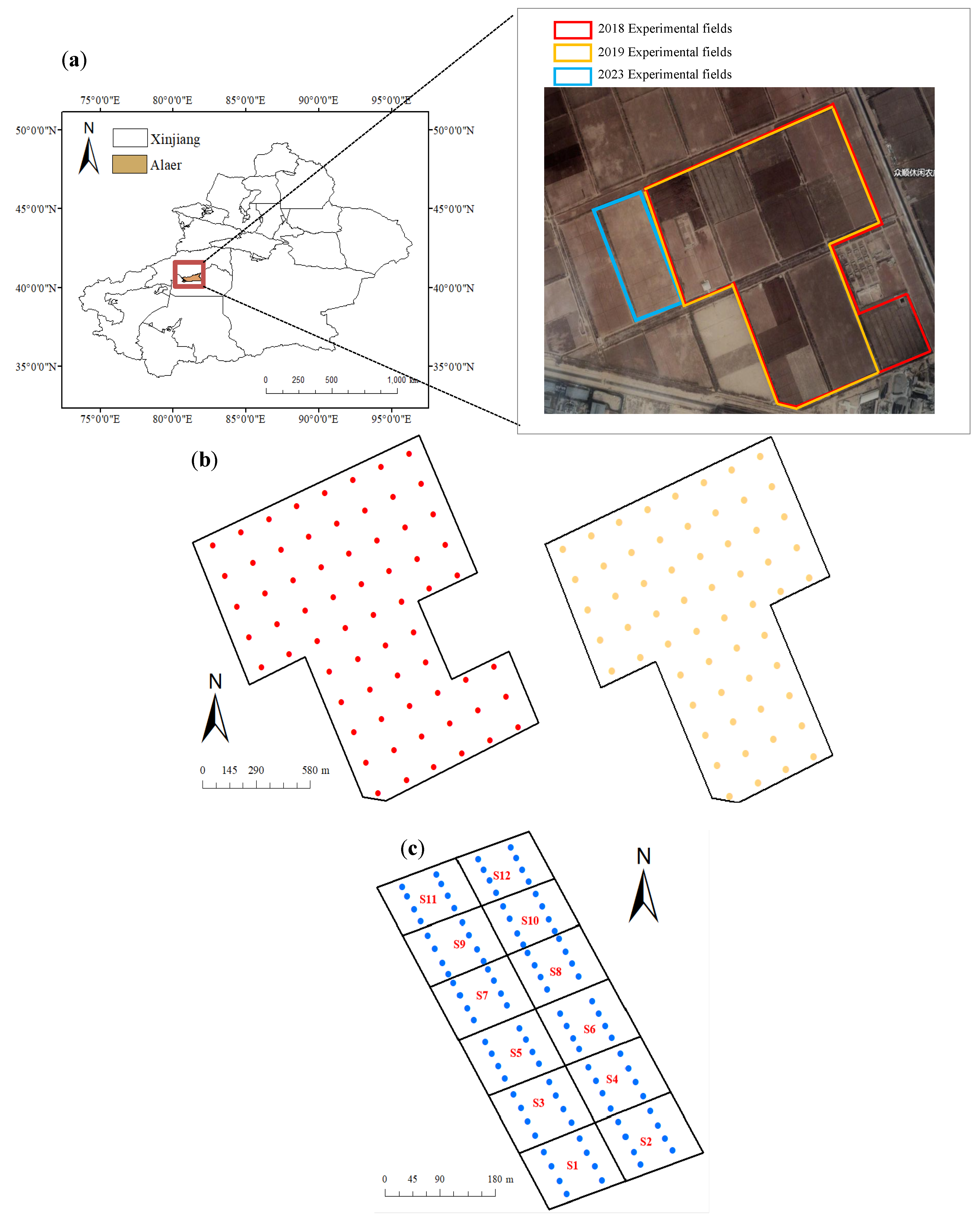
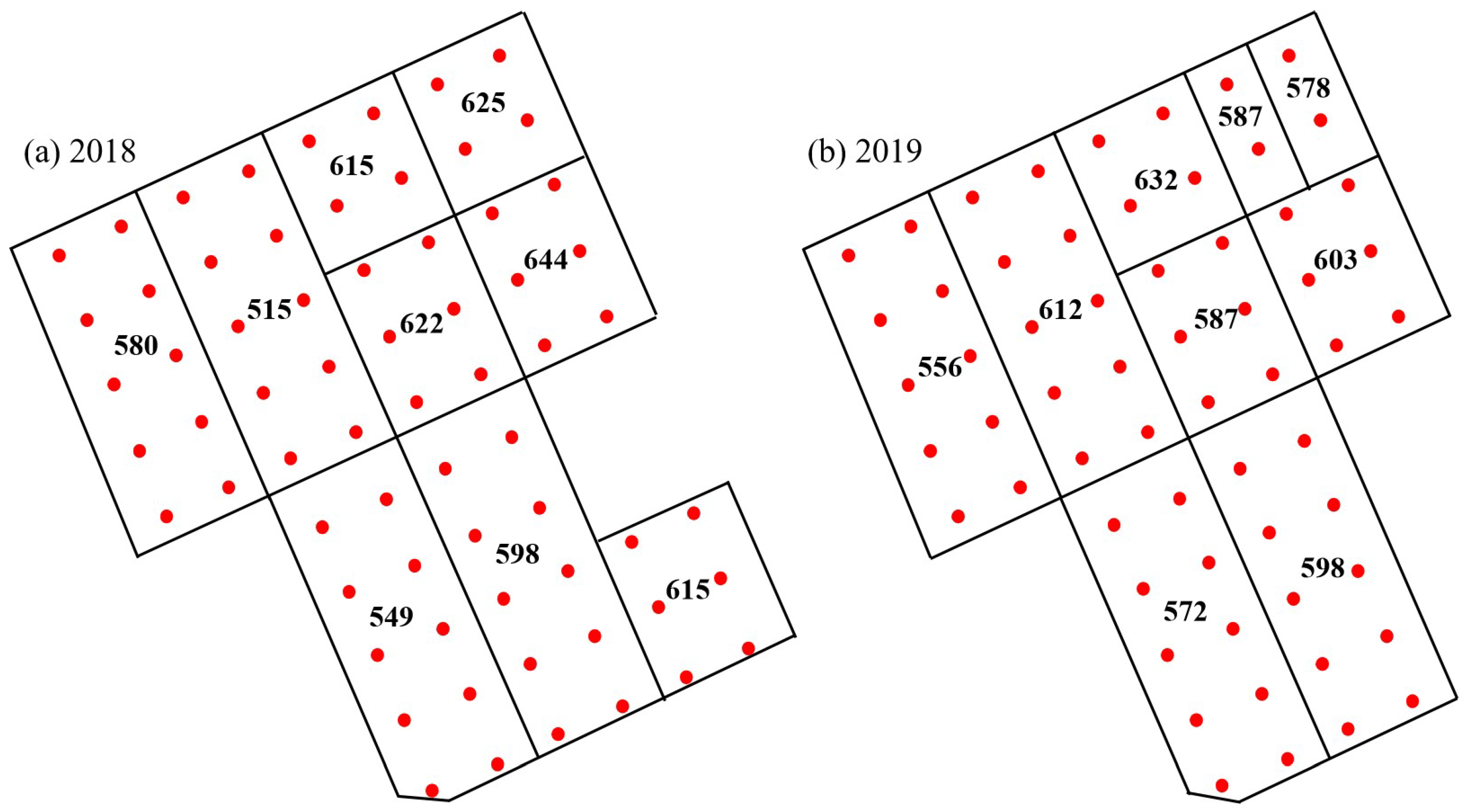
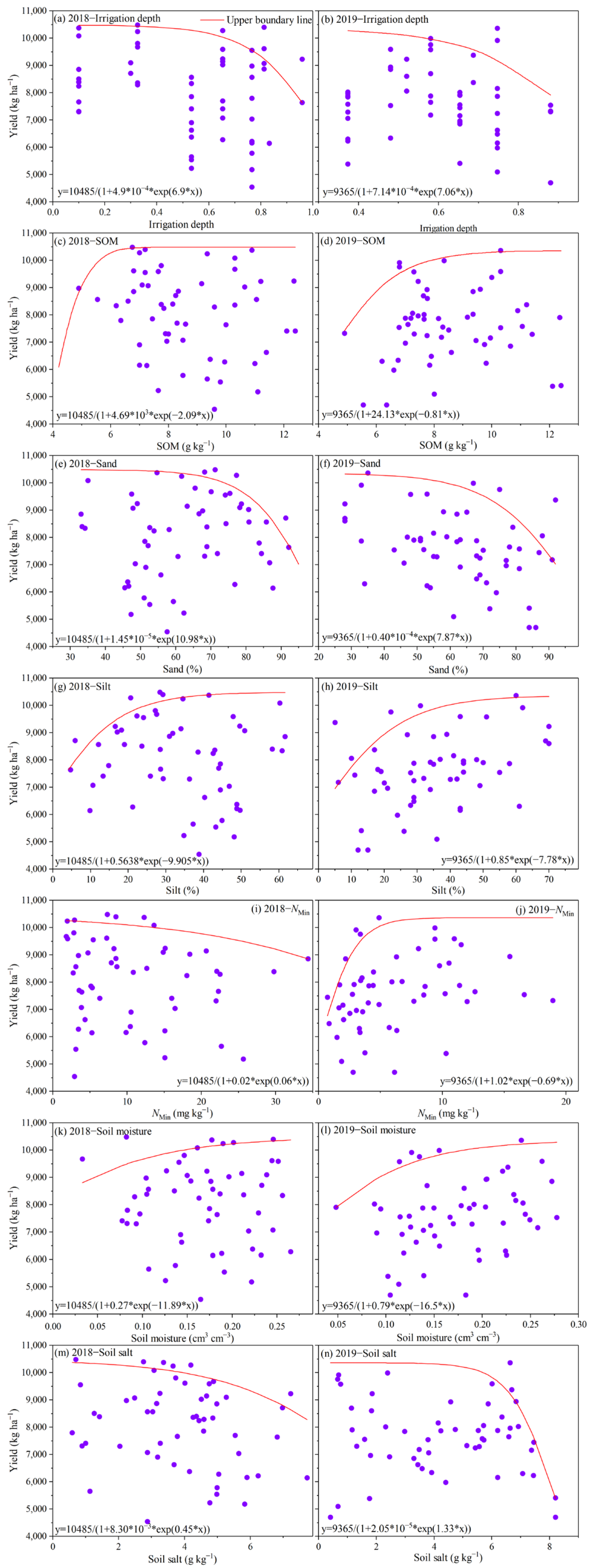


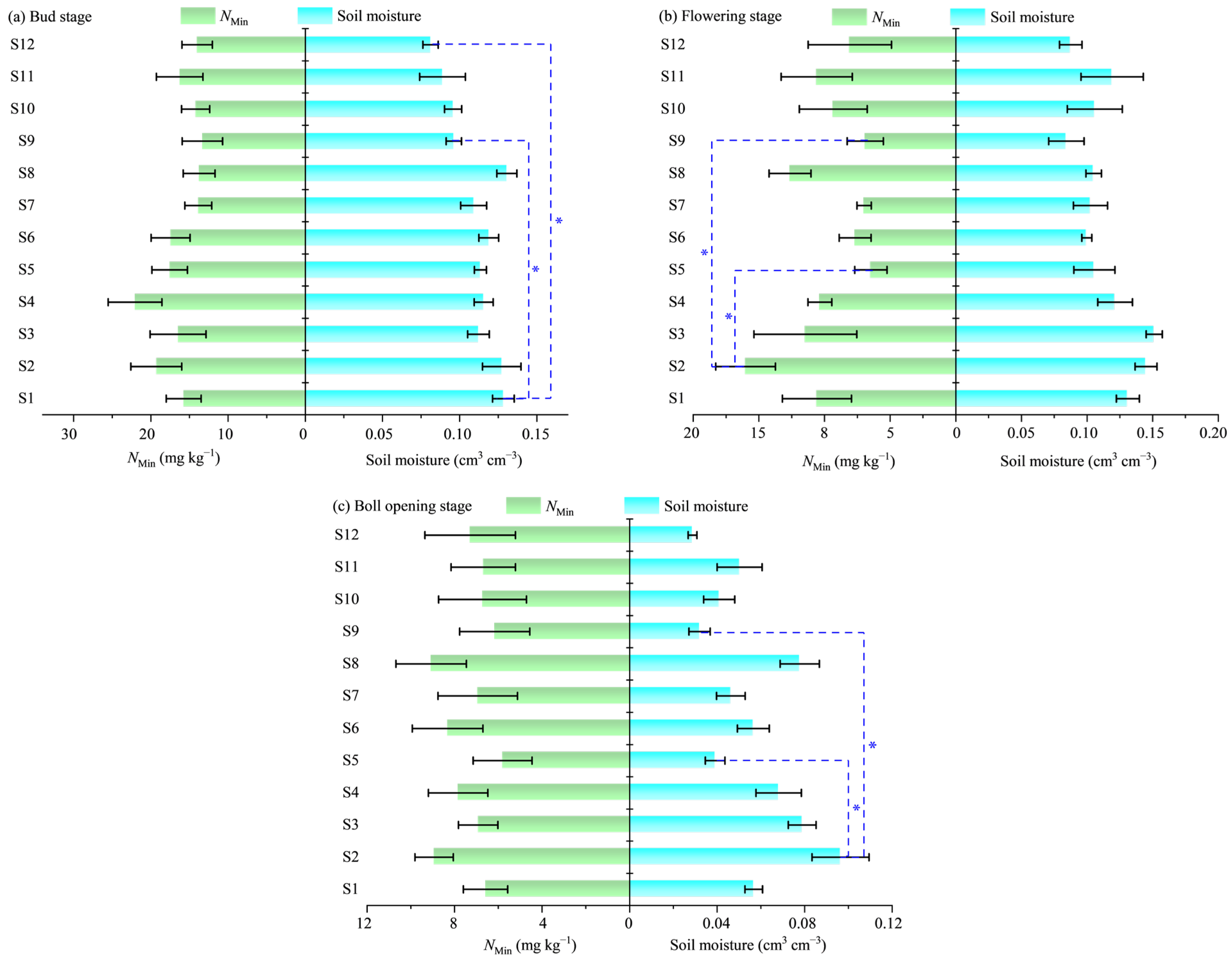
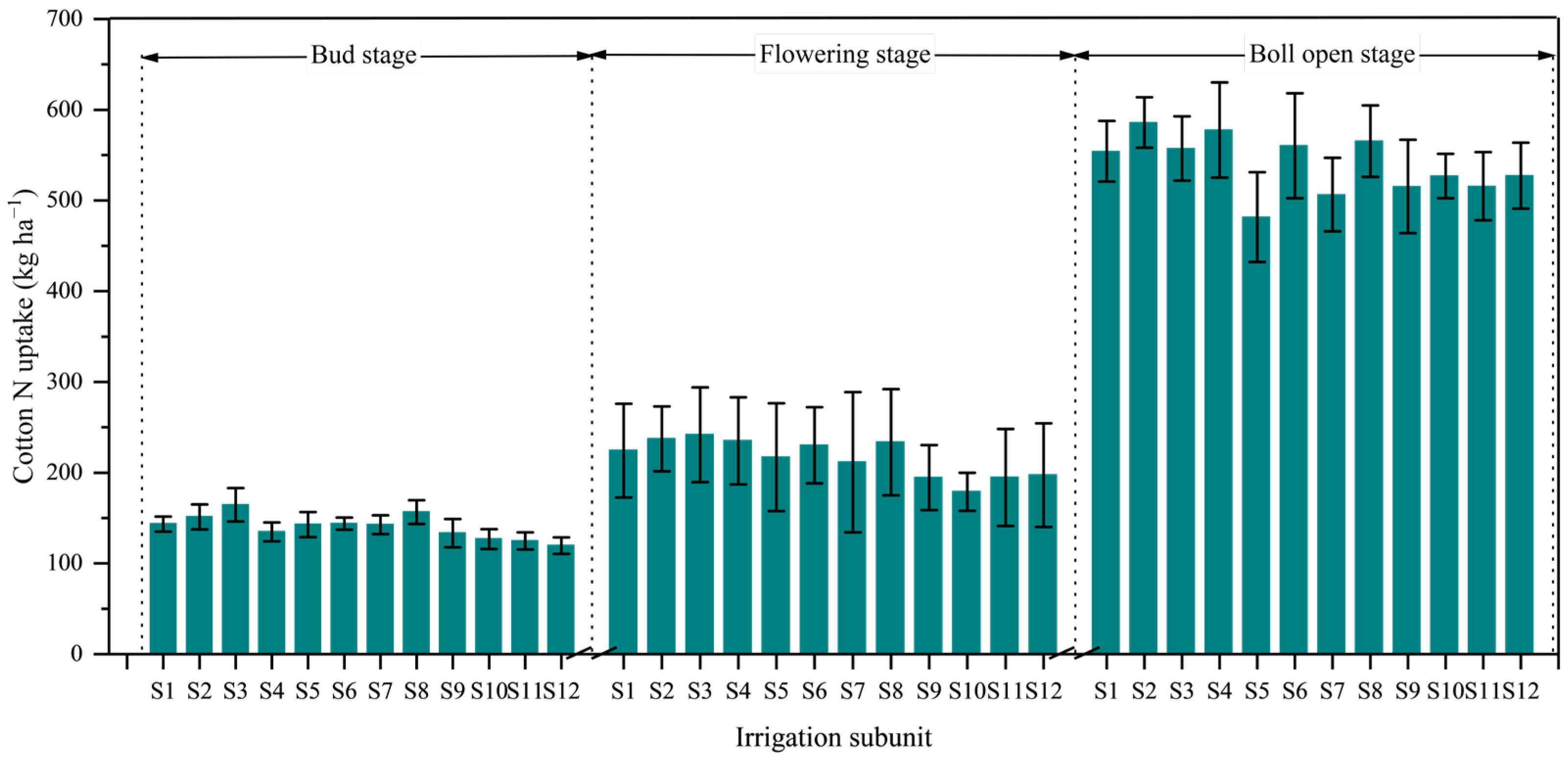
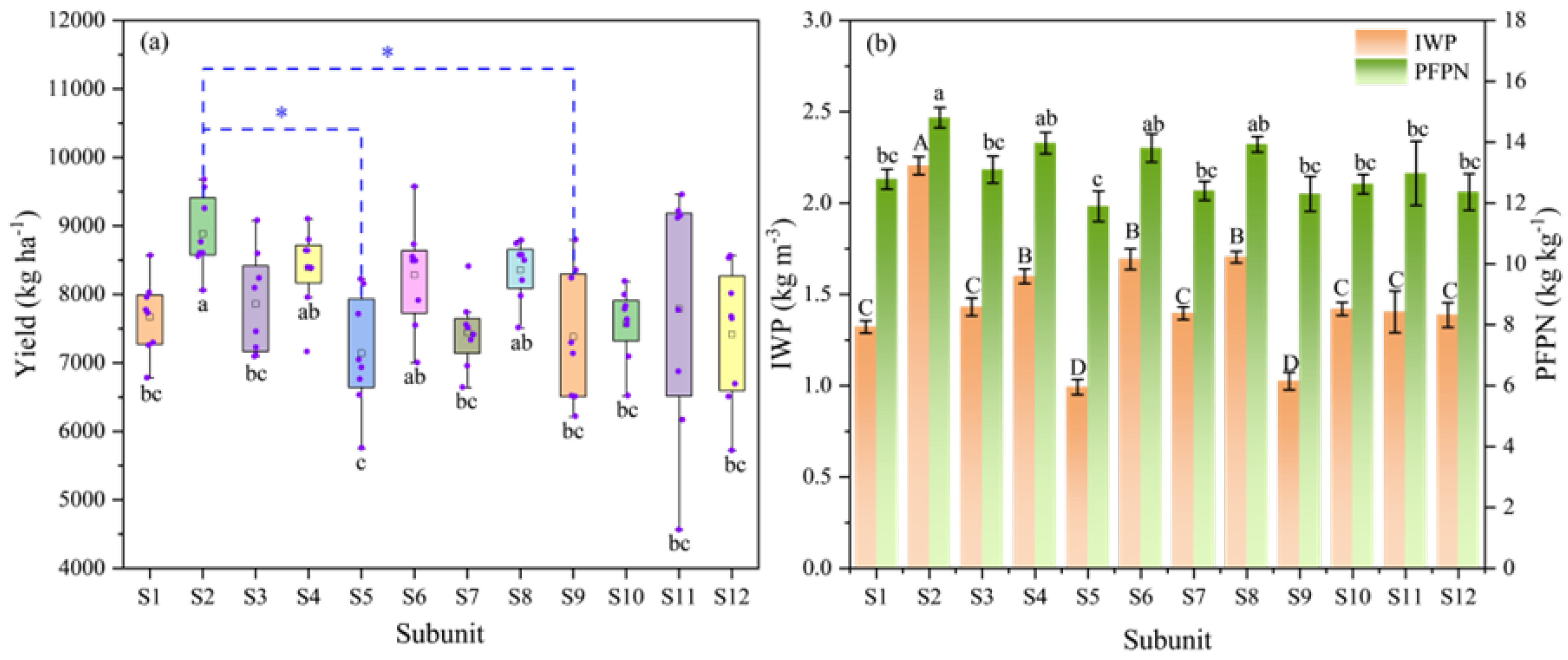
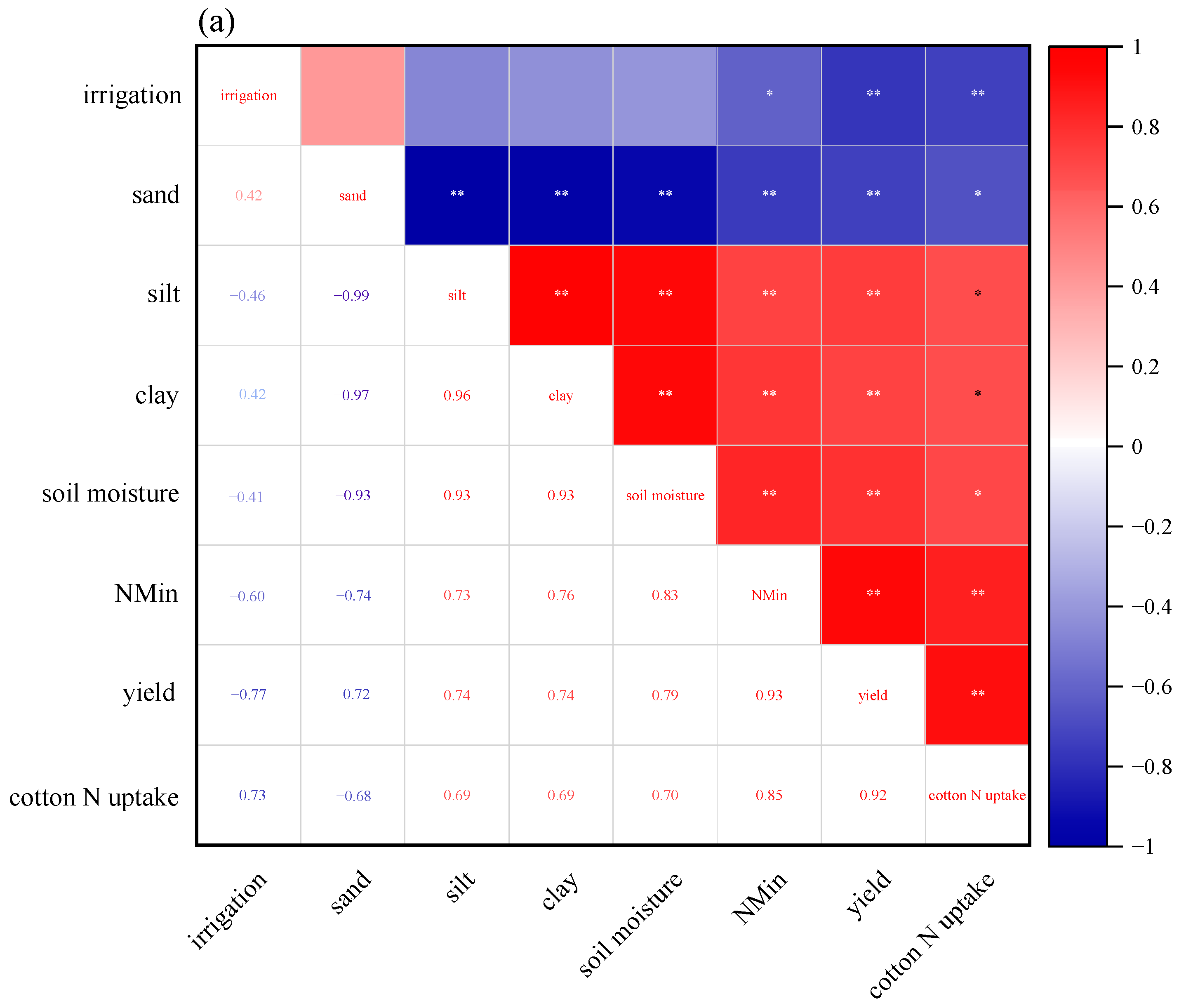
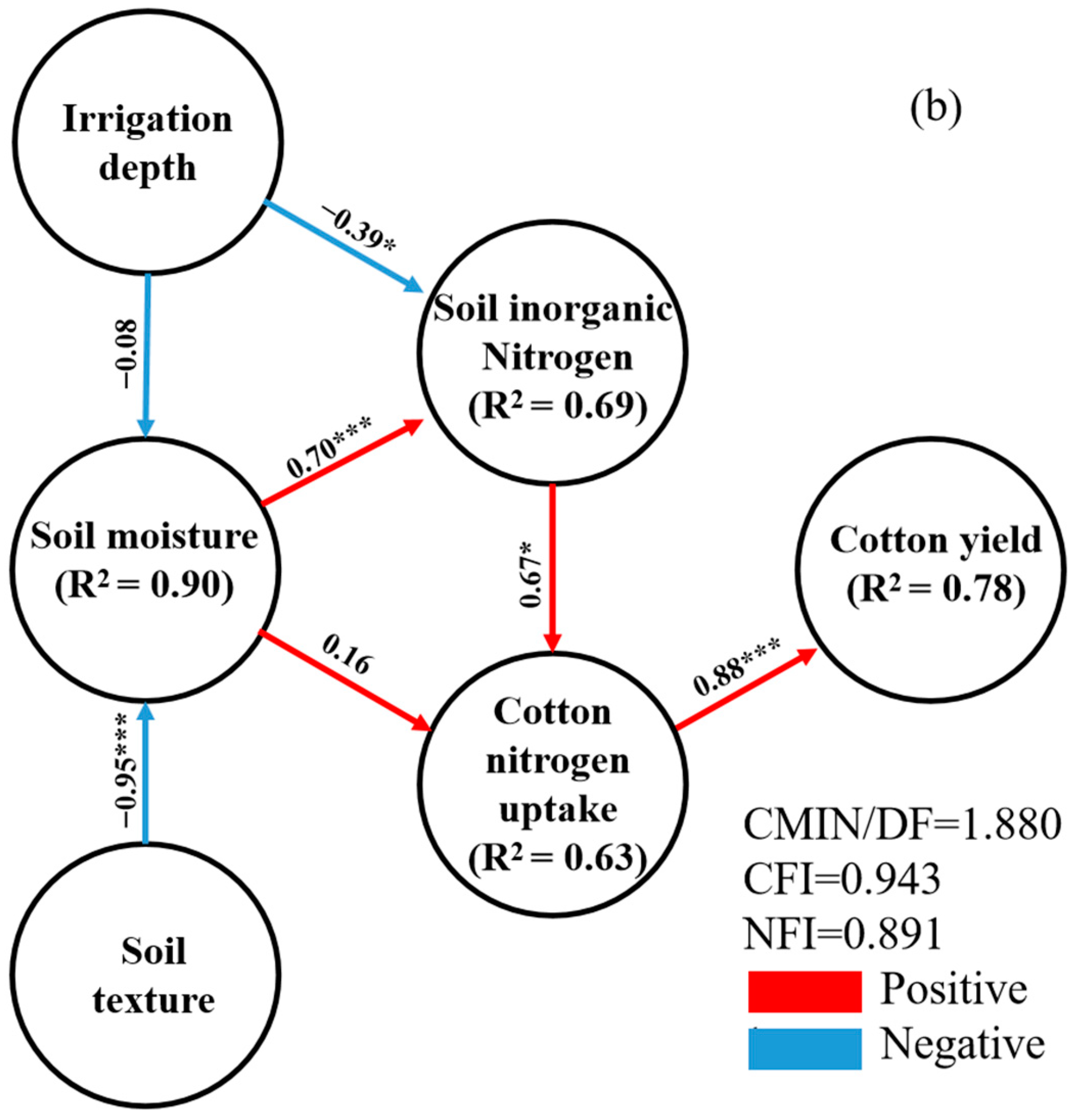
| Variable | Unit | Mean | Min | Max | Std | SK | KU | CV |
|---|---|---|---|---|---|---|---|---|
| Seed cotton yield (2018) | kg ha−1 | 8051 | 4537 | 10485 | 1533 | −0.37 | −0.69 | 19 |
| Seed cotton yield (2019) | kg ha−1 | 6617 | 3694 | 9365 | 1343 | −0.13 | −0.18 | 20 |
| SOM | g kg−1 | 8.65 | 4.90 | 12.40 | 1.81 | 0.31 | −0.67 | 21 |
| Sand | % | 63.10 | 33.02 | 92.16 | 15.61 | −0.03 | −0.79 | 25 |
| Silt | % | 33.63 | 4.72 | 61.67 | 14.71 | −0.04 | −0.77 | 44 |
| Initial water content (2018) | cm3 cm−3 | 0.17 | 0.03 | 0.27 | 0.06 | −0.22 | −0.71 | 33 |
| NMin (2018) | mg kg−1 | 10.91 | 1.81 | 34.37 | 7.96 | 0.95 | 0.29 | 73 |
| Soil salt (2018) | g kg−1 | 3.88 | 0.59 | 7.73 | 1.74 | −0.06 | −0.36 | 45 |
| Initial water content (2019) | cm3 cm−3 | 0.17 | 0.05 | 0.28 | 0.06 | 0.05 | −0.89 | 32 |
| NMin (2019) | mg kg−1 | 6.18 | 0.72 | 18.93 | 4.30 | 1.01 | 0.51 | 70 |
| Soil salt (2019) | g kg−1 | 4.31 | 0.41 | 8.21 | 2.30 | −0.15 | −1.23 | 53 |
| Variable | Depth | Min (%) | Max (%) | Mean (%) | Std (%) | SK | KU | CV (%) |
|---|---|---|---|---|---|---|---|---|
| Sand | 0~20 | 52.79 | 90.51 | 73.68 | 8.80 | −0.36 | −0.94 | 12 |
| 20~40 | 58.87 | 88.94 | 74.70 | 7.61 | −0.24 | −1.16 | 10 | |
| 40~60 | 66.62 | 92.37 | 77.84 | 6.51 | 0.63 | −0.41 | 8 | |
| 60~80 | 64.93 | 91.03 | 78.93 | 6.78 | −0.21 | −0.65 | 9 | |
| 80~100 | 56.54 | 87.07 | 76.00 | 7.03 | −0.72 | 0.07 | 9 | |
| Clay | 0~20 | 0.39 | 2.61 | 1.50 | 0.46 | 0.29 | −0.52 | 30 |
| 20~40 | 0.67 | 2.22 | 1.40 | 0.39 | 0.29 | −1.06 | 28 | |
| 40~60 | 0.33 | 1.75 | 1.15 | 0.34 | −0.62 | −0.31 | 29 | |
| 60~80 | 0.44 | 1.84 | 1.04 | 0.34 | 0.29 | −0.68 | 33 | |
| 80~100 | 0.55 | 2.85 | 1.25 | 0.56 | 1.50 | 1.54 | 44 | |
| Silt | 0~20 | 9.06 | 44.60 | 24.82 | 8.35 | 0.36 | −0.95 | 34 |
| 20~40 | 10.39 | 38.95 | 23.90 | 7.23 | 0.24 | −1.15 | 30 | |
| 40~60 | 7.30 | 31.71 | 21.01 | 6.18 | −0.62 | −0.42 | 29 | |
| 60~80 | 8.53 | 33.36 | 20.03 | 6.45 | 0.21 | −0.65 | 32 | |
| 80~100 | 12.37 | 40.61 | 22.75 | 6.53 | 0.66 | −0.06 | 29 |
| Soil Depth (cm) | Growth Period | Soil Moisture | Soil Inorganic Nitrogen | ||||||
|---|---|---|---|---|---|---|---|---|---|
| Min | Max | Mean | CV (%) | Min | Max | Mean | CV (%) | ||
| 0~20 | Seeding | 0.06 | 0.13 | 0.09 | 23 | 5.47 | 21.44 | 11.48 | 39 |
| Bud | 0.05 | 0.18 | 0.10 | 24 | 0.60 | 60.64 | 18.43 | 59 | |
| Flowering | 0.05 | 0.41 | 0.11 | 47 | 1.72 | 44.58 | 11.90 | 90 | |
| Boll open | 0.01 | 0.14 | 0.05 | 51 | 2.34 | 23.58 | 7.20 | 63 | |
| Mature | 0.02 | 0.13 | 0.06 | 37 | 2.22 | 28.87 | 7.95 | 68 | |
| 20~40 | Seeding | 0.05 | 0.14 | 0.09 | 23 | 3.87 | 49.03 | 12.12 | 82 |
| Bud | 0.05 | 0.24 | 0.12 | 29 | 1.57 | 42.36 | 13.90 | 58 | |
| Flowering | 0.05 | 0.26 | 0.12 | 39 | 0.59 | 25.09 | 7.45 | 73 | |
| Boll open | 0.02 | 0.18 | 0.07 | 56 | 2.17 | 31.58 | 7.48 | 67 | |
| Mature | 0.02 | 0.15 | 0.06 | 48 | 2.01 | 22.81 | 8.36 | 53 | |
| 40~60 | Seeding | 0.04 | 0.14 | 0.09 | 23 | 2.29 | 46.24 | 9.20 | 95 |
| Bud | 0.04 | 0.30 | 0.13 | 42 | 0.78 | 47.14 | 8.76 | 84 | |
| Flowering | 0.05 | 0.31 | 0.12 | 44 | 0.52 | 24.45 | 4.44 | 87 | |
| Boll open | 0.03 | 0.22 | 0.09 | 54 | 1.50 | 17.31 | 6.03 | 54 | |
| Mature | 0.02 | 0.28 | 0.07 | 65 | 1.50 | 31.33 | 5.50 | 72 | |
| 60~80 | Seeding | 0.06 | 0.13 | 0.09 | 18 | 2.19 | 37.78 | 8.68 | 71 |
| Bud | 0.05 | 0.31 | 0.13 | 43 | 0.53 | 24.13 | 6.26 | 77 | |
| Flowering | 0.04 | 0.29 | 0.14 | 42 | 0.73 | 38.53 | 5.50 | 91 | |
| Boll open | 0.03 | 0.26 | 0.09 | 55 | 1.65 | 17.69 | 6.26 | 59 | |
| Mature | 0.03 | 0.33 | 0.09 | 63 | 0.68 | 20.50 | 5.46 | 66 | |
| 80~100 | Seeding | 0.06 | 0.13 | 0.09 | 19 | 3.33 | 15.17 | 7.81 | 37 |
| Bud | 0.05 | 0.29 | 0.13 | 40 | 0.32 | 52.62 | 7.49 | 111 | |
| Flowering | 0.03 | 0.32 | 0.14 | 44 | 0.80 | 34.21 | 6.40 | 81 | |
| Boll open | 0.03 | 0.24 | 0.11 | 52 | 1.86 | 33.46 | 7.84 | 69 | |
| Mature | 0.01 | 0.26 | 0.10 | 55 | 1.39 | 22.58 | 5.71 | 62 | |
Disclaimer/Publisher’s Note: The statements, opinions and data contained in all publications are solely those of the individual author(s) and contributor(s) and not of MDPI and/or the editor(s). MDPI and/or the editor(s) disclaim responsibility for any injury to people or property resulting from any ideas, methods, instructions or products referred to in the content. |
© 2025 by the authors. Licensee MDPI, Basel, Switzerland. This article is an open access article distributed under the terms and conditions of the Creative Commons Attribution (CC BY) license (https://creativecommons.org/licenses/by/4.0/).
Share and Cite
Sun, Z.; Wang, Z.; Li, J. Identification and Evaluation of the Main Constraints on Cotton Production Within a Collective Drip Irrigation System in Southern Xinjiang, China. Agronomy 2025, 15, 760. https://doi.org/10.3390/agronomy15040760
Sun Z, Wang Z, Li J. Identification and Evaluation of the Main Constraints on Cotton Production Within a Collective Drip Irrigation System in Southern Xinjiang, China. Agronomy. 2025; 15(4):760. https://doi.org/10.3390/agronomy15040760
Chicago/Turabian StyleSun, Zhanghao, Zhen Wang, and Jiusheng Li. 2025. "Identification and Evaluation of the Main Constraints on Cotton Production Within a Collective Drip Irrigation System in Southern Xinjiang, China" Agronomy 15, no. 4: 760. https://doi.org/10.3390/agronomy15040760
APA StyleSun, Z., Wang, Z., & Li, J. (2025). Identification and Evaluation of the Main Constraints on Cotton Production Within a Collective Drip Irrigation System in Southern Xinjiang, China. Agronomy, 15(4), 760. https://doi.org/10.3390/agronomy15040760






